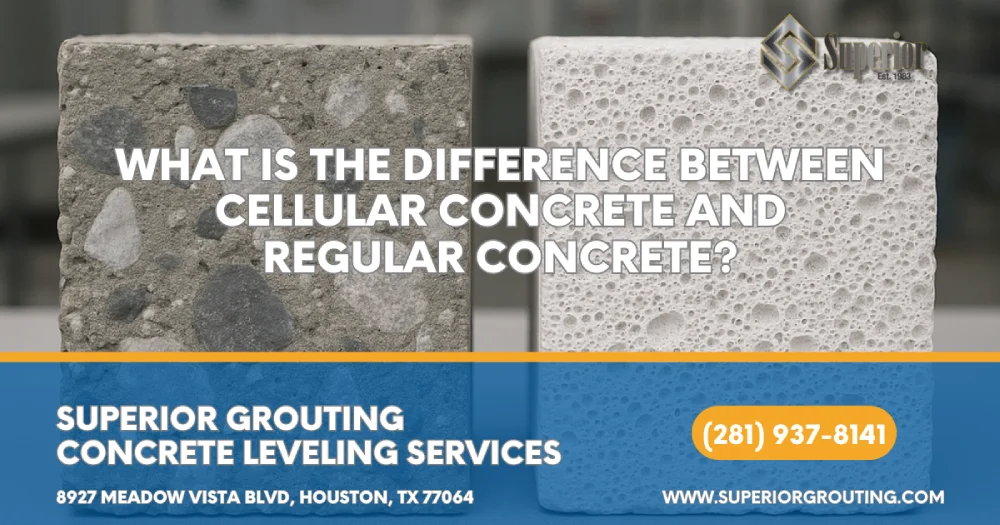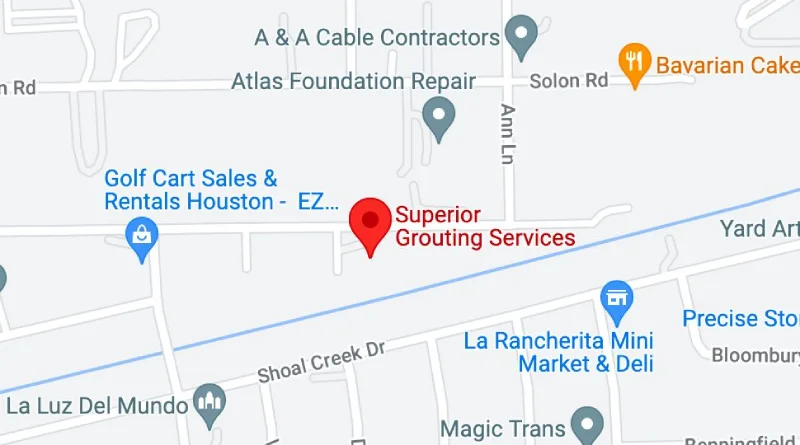What Is the Difference Between Cellular Concrete and Regular Concrete in Beaumont, TX?

Engineers along the Gulf Coast often ask whether low-density cellular concrete or traditional concrete is the smarter choice for industrial sites in Beaumont, TX. The answer revolves around density, compressive strength, longevity, cure time, and overall cost-effectiveness. By injecting preformed foam into a cement slurry, suppliers create cellular mixes that weigh far less, pump farther, and insulate better—while still delivering enough structural integrity for many geotechnical and grout stabilization tasks.
Traditional concrete, on the other hand, remains the heavyweight champion for extreme loads and abrasion resistance. Understanding both materials helps you decide when to lift and level, fill a void, or stabilize expansive clay soils with confidence.
Key Takeaways
• Cellular concrete’s foam-generated air voids cut unit weight by as much as 80 %, offering a cost-effective way to reduce dead load on pilings and subgrades in Beaumont.
• Traditional concrete excels where high compressive strength, abrasion resistance, and long-term durability under wheel or crane traffic are critical.
• Superior Grouting provides turnkey grouting services, cellular concrete placement, and polyurethane foam for concrete lifting throughout TX, including 8927 Meadow Vista Blvd in Houston.
• Cellular mixes pump through small hoses, rapidly cure, and self-level, minimizing crew size on congested industrial sites.
• Evaluating density and strength side by side ensures your concrete structures meet Gulf Coast soil conditions, storm loads, and lifecycle performance targets.
Understanding Each Type of Concrete
Traditional Concrete
Also called normal-weight or conventional concrete, this mix combines portland cement, water, sand, and crushed stone. The resulting density averages 145 lb/ft³, while 28-day compressive strength typically ranges from 3,000 psi to 6,000 psi. Because of its high strength and durability, traditional concrete remains the go-to material for heavy equipment foundations, pipe racks, bridge decks, and marine terminals from Beaumont to the Port of Houston.
Cellular Concrete
Cellular concrete—sometimes labeled low density cellular concrete, foam concrete, or lightweight flowable fill—starts with cement, water, and fine sand. A foaming agent produces billions of closed-cell bubbles that are blended into the slurry, forming a homogeneous, low-density material. Contractors frequently order densities between 25 lb/ft³ and 120 lb/ft³, tailoring the strength of cellular mixes to the job at hand. Because the foam expands uniformly, cellular concrete excels at annular space grouting, void filling, and soil stabilization where traditional concrete would be too heavy.
Density and Strength: A Side-by-Side Look
Density
• Traditional concrete: 140–150 lb/ft³
• Cellular concrete: 20–120 lb/ft³
Strength
• Traditional concrete: 3,000–6,000 psi
• Cellular concrete: 100–2,500 psi, depending on density and cement content
The key takeaway is that lower density generally means lower compressive strength. Yet in many geotechnical applications—backfilling abandoned pipelines, stabilizing voids beneath industrial slabs, or raising grades above flood levels—strength of cellular concrete in the 400- to 2,000-psi range is more than sufficient.
Performance in Gulf Coast Conditions
Thermal and Acoustic Insulation
Trapped air provides superior thermal and acoustic insulation. On an industrial site operating in 100 °F summer heat, a 90 lb/ft³ cellular layer beneath a process floor can lower HVAC loads and dampen compressor noise without additional insulation boards.
Pumpability and Workability
Cellular concrete flows like grout, reducing pumping pressure and eliminating segregation. Crews can snake 1-in. hoses 1,500 ft around pipe racks or under vessels—something regular concrete cannot match without high-pressure boom trucks.
Cure Time and Rapid Return to Service
Because foam displaces aggregate, less water is trapped inside the matrix. Cellular mixes often reach handling strength in hours, supporting rapid cure schedules critical for plant turnarounds or time-sensitive void filling beneath active rail lines. Superior Grouting’s rapid-cure formulations cut shutdown windows even further.
Applications Across Industrial and Infrastructure Projects
When Traditional Concrete Is Best
• Heavy-duty pavements subjected to repetitive forklift or crane loads
• Column footings and pile caps needing high structural capacity
• Caustic containment areas where chemical-resistant overlays must bond to a dense base
• Marine structures where abrasion from barge impact and saltwater demands maximum durability
When Cellular Concrete Excels
• Void filling and annular space grouting around slip-lined pipes
• Lightweight backfill behind MSE walls and bridge approaches over soft soils
• Raising sunken concrete slabs with low density cellular concrete to reduce future settlement
• Thermal insulating roof decks on petrochemical control buildings
• Soil stabilization in areas with expansive clay soils, where added mass from traditional concrete would worsen heave
Concrete Lifting and Leveling: Foam vs. Cellular
High-density polyurethane foam for concrete lifting, marketed by Superior Polylift™, is injected through 5/8-in. holes drilled into the concrete surface. The foam expands, fills voids, and rapidly cures, allowing traffic to resume in under an hour. Cellular grout, by contrast, is pump-placed through 1- to 2-in. ports and self-levels beneath large slabs or equipment pads. Both options surpass mud-jacking for uneven concrete slabs, but the correct choice depends on load, access, and required density and strength.
Environmental and Economic Advantages
Fewer Truck Trips
Because one ready-mix truck can haul nearly twice the cubic yards of an 85 lb/ft³ cellular blend compared to traditional concrete, contractors slash diesel costs and emissions—an important advantage for Gulf Coast region sustainability goals.
Lower Raw Material Use
Cellular concrete replaces stone with air, reducing aggregate extraction and cement consumption. Supplementary cementitious materials—fly ash or slag—can further lower the carbon footprint without sacrificing compressive strength.
Cost-Effectiveness
Up-front unit costs may be higher, but savings on haul, labor, and formwork usually make cellular concrete the more cost-effective option for large-volume backfill and void filling. Superior Grouting’s grouting services demonstrate that total installed cost often drops 20–30 % compared to traditional approaches.
Why Choose Superior Grouting Services
Superior Grouting, headquartered at 8927 Meadow Vista Blvd, Houston, TX, offers cellular concrete, grout stabilization, and polyurethane foam concrete lifting across the Gulf Coast. Our engineers evaluate density and strength, specify preformed foam ratios, and tailor cure times to each industrial site. Whether you need low density cellular concrete for pipeline abandonment in Beaumont or high-density polyurethane foam to lift and level uneven concrete at a Pasadena terminal, we supply turnkey solutions that meet strict schedule and safety demands.
Contact Superior Polylift today for a geotechnical assessment, density optimization, and a no-obligation quote on concrete leveling services 8927 Meadow Vista.
Conclusion
In Beaumont, TX, the difference between cellular concrete and regular concrete boils down to density and the resulting performance trade-offs. Traditional concrete delivers unmatched compressive strength and surface durability, while cellular concrete provides lightweight pumpability, rapid cure, and superior thermal benefits. By analyzing soil conditions, structural loads, and lifecycle costs, you can select the type of concrete that maximizes structural integrity, longevity, and cost-effectiveness. For expert guidance, turn to Superior Grouting’s comprehensive grouting services in Houston and throughout the Gulf Coast.


